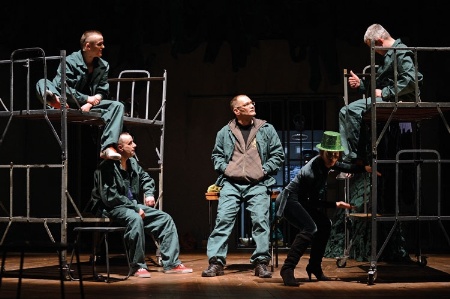Intelligent, observant readers can always offer new insights, although the deluge of scholarly articles makes it harder to find the gold amid the dross
In performance, Shakespeare can safely be left to look after himself. His plays deal in primal emotions and obviously have a broad appeal. Tickets for Kenneth Branagh’s recent Macbeth at the Manchester International Festival sold out in less than 10 minutes. All‑male productions, all-female productions, productions in dozens of languages from every corner of the Earth all manage to pull in the crowds, and it seems to be possible to stage some of the plays in just about any setting. So we get King Lear in a children’s playground, Henry V in Iraq or Measure for Measure in Freud’s Vienna, while Romeo and Juliet cries out to be relocated to a sectarian city such as Belfast or Beirut.
Every director and actor inevitably brings something new to a familiar text and interprets it in subtly different ways from their predecessors. Lewd or gay subtexts can be played up or played down. A character such as Shylock may be touching or terrifying, repellent or ridiculous. Petruchio and Katherina’s relationship in The Taming of the Shrew may be portrayed as abusive, slapstick or playfully flirtatious (in an S&M kind of way). And, although we know virtually nothing about the man, Shakespeare’s presence remains as solid in the theatre as in the souvenir shops of Stratford-upon-Avon.
But what about the parallel academic industry of Shakespeare studies?
In 2006, Laurie Maguire, professor of English language and literature at the University of Oxford, produced a curious book, Where There’s a Will There’s a Way, promoting Shakespeare as a “life coach” for the Sex and the City generation. Yet she also notes how many academics think it more impressive to discuss Shakespeare in terms of “epistemology and representation and semiotics and différance and liminality and cultural positions” rather than to talk at all personally about jealousy, love or loss.
Shakespeare is such a vast cultural icon in the English-speaking world that every new school of critical analysis and jargon soon gets applied to him, so we’ve had lots of Christian and Marxist Shakespeares, psychoanalytic, deconstructed and postmodern Shakespeares, and postcolonial and queer Shakespeares. At the same time, more traditional scholars continue to bring to bear Elizabethan or Jacobean social history on the plays, which can run the risk of turning Shakespeare into something antiquarian, requiring prior knowledge of the rhetorical handbooks, property law or theological disputes of his times.
All this raises two big questions. What is the relationship between historicist and “contemporary” approaches? Even more fundamentally, how much is there still left for academics to say about Shakespeare that is new, true and important?
Farah Karim-Cooper is head of higher education and research at Shakespeare’s Globe.
“When new historicism came on to the scene,” she recalls, “it created a wave of Shakespeare criticism that dug deep into the cultural history of his period, looking at rare books and manuscripts that surround Shakespeare and throw new light on his plays. Understanding property law helps you understand what the implications might be for Capulet [in Romeo and Juliet] for his only child to marry the son of his greatest enemy. It packs more of a punch when you read history into Shakespeare.”
Karim-Cooper’s first book, published in 2006, is titled Cosmetics in Shakespearean and Renaissance Drama. This draws on her research into “a huge number of tracts written in the Elizabethan period about women who paint their faces and use cosmetics, basically arguing that it is evil, sinful”. The theatre companies not only made extensive use of cosmetics but also subverted this “horribly misogynistic” discourse and used it as “a principal metaphor for defining what is good art and what is bad art. Shakespeare engages with it in a variety of ways, for example in the early Sonnets when he’s trying to convince the young man to get married and have children so his beauty is preserved: reproduction becomes a sort of cosmetic process.”
Disputing the notion that academic writing has to be detached and bloodless, Karim-Cooper says she was “passionate about uncovering an aspect of women’s history in relationship to Shakespeare” that also feeds into today’s debates about body image.
Brian Vickers, distinguished senior fellow at the University of London’s School of Advanced Study, published his first book on Shakespeare in 1968 and believes that “intelligent, observant readers” can always offer new insights into the plays – although the deluge of scholarly articles makes it ever harder to find the gold amid the dross. He also has strong views on the right and wrong approaches, as he set out in a 1994 book, Appropriating Shakespeare: Contemporary Critical Quarrels.
“What I am bothered about”, he explains, “is looking at a historical phenomenon through a present-day lens. The lens is a distorting glass focusing in on some issues in a particular play and totally excluding others.
“The plot of Othello is set in motion by the jealous and resentful Iago, who hates Othello and sets out to destroy him using Desdemona as the tool. The first generation of feminist critics seized on the play as an instance of Shakespeare’s misogyny and started with Act Three. That seems to me a partial, distorting reading of the play: if you can’t register the presence of Iago, who creates all the destruction and ends up destroying everybody, including himself, you are not reading, you’re imposing a particular scheme, only interested in the harm that men do to women – not who causes it, not the anguish and agony Othello goes through.”
Similar problems, in Vickers’ view, mar psychoanalytic and postcolonial criticism.
Sarah Dustagheer, lecturer in early modern English at King’s College London, is exploring the difference between outdoor and indoor performances in Shakespeare’s England, since his company had two playhouses and he started writing for the smaller, more expensive indoor theatre at Blackfriars (now being reconstructed by the Globe) after 1609. She has carried out “detailed historical research about the playhouses, the spaces, legal aspects of their existence, the ways they were regulated by governments and their repertories”, since “we haven’t explored Shakespeare fully in the context of the industry in which he worked. There definitely are areas that are unexplored.”
But although her own work is rooted in historical analysis, she is supportive of different and more “contemporary” approaches and sees “almost a separation between Shakespeare as a playwright in his own time and what [he] has become in the 400 years since his death. He is now an icon and indicative of ongoing cultural debates we have about homosexuality, about sexism, about colonialism.

Until recently, there was no adequate edition of Antony and Cleopatra…the example is still there to remind us that improvement is not an illusion
“Shakespeare has become a space to think through different critical approaches. It’s not just that Marxism and feminism are applied to the plays but the plays help scholars think through the issues of Marxism or feminism. It’s a two-way process.”
Dustagheer adds: “Feminism has been incredibly revelatory for how we understand Shakespeare, even in its original context, looking at the gender structures Shakespeare is playing with that hadn’t really been explored properly before. So if you shut off these new approaches, you are also shutting off an understanding of the text in its own time.”
All this is very interesting, but what about the needs of more ordinary readers, such as the students who Emma Rees, senior lecturer in English at the University of Chester, teaches on her final-year Shakespeare undergraduate module?
Many, she reports, are “coming to some of the plays for the first time. While they may be familiar with Romeo and Juliet (thank you, Baz Luhrmann), for the most part they don’t know much about The Taming of the Shrew or The Merchant of Venice. They ‘discover’ these plays with a sense of such understanding and awe that they are revivified for me, too.
“When Channel 4’s controversial My Big Fat Gypsy Wedding was first aired, for example, some of my students suddenly ‘got’ Baptista’s control of his daughters and Katherina’s rebellion [in The Taming of the Shrew] in a way they might not otherwise have done. When the members of Pussy Riot were imprisoned and I showed my students a picture of a scold’s bridle, the nature of the threat to patriarchy of Katherina’s volubility made sense.”
She adds: “There’s a very clear feeling among them that in order to be a Proper English Graduate, they need to take their Shakespeare like they take cough mixture…When I started teaching the module more than a year ago, I was shocked by how few of the participants had seen live theatre – any live theatre.”
The most obvious tools academics can provide such people are editions of individual plays, usually in complete series put out by a number of leading publishers.
The Shakespeare canon splits pretty neatly into two. About half the plays were published for the first time in the Folio of 1623 and so have to be reconstructed from a single source. The other half had previously appeared in one or more quarto editions. The two groups present rather different challenges.
Modern editors have to establish a text, explain some of the lines likely to cause difficulties and offer an overall interpretation of the play. They and their publishers obviously have an interest in claiming that they have produced something dramatically new (and thus implicitly that their predecessors got things badly wrong). Yet in cases where there are no major textual issues, is this plausible? Can one really expect a fresh edition to include more than a handful of new readings and new interpretations of lines that have escaped all earlier critics? Can it really offer a major new perspective on the “meaning” of a work as a whole?
Such burgeoning editions, in other words, may well make sense for publishers and for academics seeking to build reputations, but do they really generate new knowledge or just yield rapidly diminishing returns?
“If you can’t think of new things to say in a commentary, you shouldn’t be doing it,” says Henry Woudhuysen, rector of Lincoln College, Oxford, who was responsible for the Arden edition of Love’s Labour’s Lost in 1998. Although he came up with “very few completely new readings in textual matters”, he “found bits that had never been annotated before, though they made no sense. People tend to write notes on passages that other people have written notes on.”
He adds: “I thought it best to annotate all the sexual innuendoes. There’s a whole area of sexual language and banter that people are a bit squeamish about, and good reference tools have existed only since the 1980s.”
It is widely agreed that digital tools offer a depth of understanding of early modern English usage that was just not possible before.
A more general response comes from John Kerrigan, professor of English at the University of Cambridge.
“Until surprisingly recently, there was no adequate edition of Antony and Cleopatra [a major play with only a Folio early edition], one that thoroughly checked the language of the play in the Oxford English Dictionary, glossed perceptively, thought about theatre history, made proper use of Shakespeare’s source in Plutarch, and placed the tragedy in a full, historical context. We now have much better editions so making improvements will be more difficult, although the example is still there to remind us that improvement is not an illusion.
“This applies more largely to the critical perspective provided by introductions. When I was young, you’d not have thought race and cultural difference were complicated factors in Antony and Cleopatra. Rome and Egypt were reduced almost to symbolic poles of order versus pleasure in the human psyche. Much the same goes for Othello, where race, when thought about at all, was done so anachronistically. General thinking about race and cultural difference, and historical understanding of how they were constructed in the early modern period, has advanced and continues to change. The same goes for gender, money, religion, attitudes to the monarchy, and all the other variables of life.

“Introductions need to respond to our changing, collective agenda.”
Anyone who doubts how “fashions” change need only look at the notorious 1958 introduction to Othello by M. R. Ridley in the Arden Shakespeare (second series). His thoughts on the protagonist included the following: “To a great many people the word ‘negro’ suggests the picture of what they would call a ‘nigger’, the woolly hair, thick lips, round skull, blunt features, and burnt-cork blackness of the traditional black nigger minstrel…There are more races than one in Africa, and that a man is black in colour is no reason why he should, even in European eyes, be sub-human. One of the finest heads I have ever seen on any human being was that of a black conductor on an American Pullman car.” Such ghastly racist claptrap remained in print until the third series Arden Othello in 1997.
Also common in editions today are accounts of the performance history of particular plays. While Kerrigan admits that cynics might see this as creating “the sort of built-in obsolescence that publishers welcome”, he believes it is still valuable for readers of Timon of Athens and Macbeth, for example, to hear about “the important recent productions with Simon Russell Beale and Kenneth Branagh in the lead roles. Since both Beale and Branagh brought new insights, as well as now being lodged in the tradition of performance that will shape future productions of the plays, it is hard to quarrel with the case for updating editions of both plays, and for those updates being improvements.”
We never get a second chance to make a first impression and to that extent it matters whether Hamlet comes on stage wishing that his “too too solid” or his “too too sullied flesh would melt”. And that is only the start. Hamlet, King Lear and several of the other best-known Shakespeare plays have generated vast mountains of speculation about the different (sometimes dramatically different) versions of the texts that have come down to us.
Do cut passages indicate the playwright’s second thoughts, a pragmatic decision taken in production or the printer running out of paper? Do incomprehensible phrases simply represent compositor errors, failed attempts to decipher Shakespeare’s original handwriting (of which we may or may not have an extended sample) or insertions by actors failing to recall accurately what some of the other characters said? Do we ever have more than one version of the same play from Shakespeare’s hand, allowing us to see or at least speculate about his working processes? And were the texts we have in any sense intended for reading as well as performance?
Disputes about these issues, although ferocious and fascinating, are also very technical. If editors believe that different texts of the same play point to a single lost original, it is obviously up to them to pick and choose the variant readings they happen to like. Others have decided that they think several versions equally authentic and have chosen to print two alternative Hamlets or three alternative Lears in the same edition.
For Philip Edwards, editor of the New Cambridge Hamlet, “Everyone who wants to understand Hamlet, as reader, actor or director, needs to understand the nature of the play’s textual questions and to have his or her view of the questions in order to approach the ambiguities in the meaning.”
This is quite a claim. Given that the textual dilemmas are both complicated and fiercely contested, does this not effectively take Hamlet out of the reach of general readers and theatregoers, and put it firmly in the hands of specialists? And does it make sense to say anything about the style or meaning of a play until we know we’ve got pretty close to “the real thing”? (That would presumably be like discussing a painter’s technique on the basis of a poor reproduction.)
Here, too, Kerrigan begs to differ, saying that trying to get to grips with the textual questions is “not essential but enriching”.
“Readers and actors of Shakespeare should be able to trust an editor to produce a cogent text of Hamlet,” he acknowledges. “But they ought to at least have a sense that other equally cogent texts could be produced and that there is no final, definitive, ‘correct’ text…I doubt that readers and actors are fazed by knowing that a single, settled text cannot be agreed upon. In the theatre, bits of text are cut all the time, the play is fluid, people know about films being released in one form, adapted for viewing before the watershed, re-released as ‘The Director’s Cut’, etc. The organic unity of the artwork is something that the public assumes less and less in an age of mechanical adaptation, instant Photoshopping and the aftermath of postmodernism.”
It is a curious aspect of speaking to academic Shakespeareans – who have, after all, chosen to devote most of their waking hours to the Bard – that they are very resistant to attempts to sanctify Shakespeare and often imply that the main benefit of their research is to make him seem less superhuman.
Karim-Cooper points to “research in digital linguistics that has produced evidence that Shakespeare didn’t coin as many new words as the master narratives spun by 18th-century Bardolatry imply”. Dustagheer asserts that “British people often bring all kinds of expectations and meanings to the study of Shakespeare – which need stripping away”. And Vickers is highly critical of editors who refuse to look at clear evidence of collaboration on the grounds that “Shakespeare was a genius and didn’t need anyone to help him, so the canon is all those plays in the Folio in toto. You get into a kind of fetishisation of the printed texts, ignorant of the fact that every dramatist in this period took part in something from five to 20 collaborative plays.”
Fortunately, enthusiasm keeps breaking through this detached stance, with the experts also revealing that they have found Shakespeare as life-changing as many other people.
Rees will “never forget seeing Greg Hicks’ Lear at the Courtyard in Stratford. It was wonderful. When it moved up the road to the Royal Shakespeare Theatre, I went to see it again. In the intervening months, my father had died from a particularly slow, malign cancer. Scenes that before had interested me had now come to affect me profoundly. The old play was new. Shakespeare’s always new.”
Vickers, too, had his revelatory moment with Lear on stage, although he generally thinks that “updating plays is a risky business, since very often the anachronisms jar”. This was a modern-dress Italian production he saw in Zurich, where “Goneril and Regan tore into each other with a ferocity and vehemence I had never imagined – because I’m English. Whoever got to the poison chest quicker was going to do for the other.”
If Italian actors are still able to uncover new dimensions to Shakespeare, there must be hope for anglophone academics.
Register to continue
Why register?
- Registration is free and only takes a moment
- Once registered, you can read 3 articles a month
- Sign up for our newsletter
Subscribe
Or subscribe for unlimited access to:
- Unlimited access to news, views, insights & reviews
- Digital editions
- Digital access to THE’s university and college rankings analysis
Already registered or a current subscriber? Login




